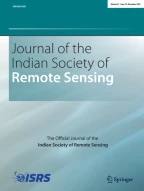Abstract
Rapid urbanization, intense infra-structure development and increased tourism related activities have resulted in the change of landscape of the Kodaikkanal town and its surrounding, a popular hill town in Tamilnadu, South India. As an after effect, the numbers of landslides and rock-falls have increased steadily in the past decade. Landslide susceptibility analysis is carried out for this area using conditional probability analysis. The geo-spatial database for mapping landslide susceptibility consists of the factors - Relief, Slope, Aspect, Curvature, Weathering, Land use, Topographic Wetness Index and Proximity to road. Two sampling strategies – point and seed-cell are compared for landslide susceptibility mapping. The Landslide Susceptibility map developed using conditional probability method is verified using R index for both sampling strategies. The study shows that both the sampling strategies perform with good accuracy, seed cell technique excels slightly over point sampling. 86.11% of the landslides fall in the high and critical susceptible zones. The results show that conditional probability technique provides a simple tool for susceptibility analysis. The method can be used at regional scale and is a valuable input for planning purpose.
Similar content being viewed by others
References
Aleotti, P., & Chowdhury, R. (1999). Landslide hazard assessment: summary, review and new perspectives. Bulletin of Engineering Geology and the Environment, 58(1), 21–44.
Ayalew, L., & Yamagishi, H. (2005). The application of GIS-based logistic regression for landslide susceptibility mapping in the Kakuda-Yahiko Mountains, Central Japan. Geomorphology, 65(1/2), 15–31.
Baeza, C., & Corominas, J. (2001). Assessment of shallow landslide susceptibility by means of multivariate statistical techniques. Earth Surface Processes and Landforms, 26, 1251–1263.
Bai, S., Lü, G., Wang, J., Zhou, P., & Ding, L. (2010). GIS-based rare events logistic regression for landslide-susceptibility mapping of Lianyungang, China. Environmental Earth Sciences. doi:10.1007/s12665-010-0509-3.
Clerici, A., Perego, S., Tellini, C., & Vescovi, P. (2002). A procedure for landslide susceptibility zonation by the conditional analysis method. Geomorphology, 48, 349–364.
Duman, T. Y., Can, T., Gokceoglu, C., & Nefeslioglu, H. A. (2005). Landslide susceptibility mapping of Cekmece area (Istanbul, Turkey) by conditional probability. Hydrology and Earth System Sciences Discussions, 2, 155–208.
Ercanoglu, M. (2005). Landslide susceptibility assessment of SE Bartin (West Black Sea region, Turkey) by artificial neural networks. Natural Hazards and Earth System Science, 5, 979–992.
Ermini, L., Catani, F., & Casagli, N. (2005). Artificial Neural Networks applied to landslide susceptibility assessment. Geomorphology, 66, 327–343.
Gokeceoglu, C., & Aksoy, H. (1996). Landslide susceptibility mapping of the slopes in the residual soils of the Mengen region (Turkey) by deterministic stability analysis and image processing techniques. Engineering Geology, 44(1–4), 147–61.
Gomez, H., & Kavzoglu, T. (2005). Assessment of shallow landslide susceptibility using artificial neural network in Jabonosa River basin, Venezuela. Engineering Geology, 78, 11–27.
Guzzetti, F., Carrara, A., Cardinali, M., & Reichenbach, P. (1999). Landslide hazard evaluation: a review of current techniques and their application in a multiscale study, Central Italy. Geomorphology, 31, 181–216.
Irigaray, C., Fernández, T., El Hamdouni, R., & Chacón, J. (2007). Evaluation and validation of landslide-susceptibility maps obtained by a GIS matrix method: examples from the Betic Cordillera (southern Spain). Natural Hazards, 41, 61–79.
Keefer, D. K., & Larsen, M. C. (2007). Assessing landslide hazards. Sciences, 316, 1136–1137.
Lee, S., & Pradhan, B. (2006). Landslide hazard mapping at Selangor, Malaysia using frequency ratio and logistic regression models. Landslides, 4, 33–41.
Magliulo, P., Di Lisio, A., Russo, F., & Zelano, A. (2008). Geomorphology and landslide susceptibility assessment using GIS and bivariate statistics: a case study in southern Italy. Natural Hazards, 47, 411–435.
Naranjo, J. L., van Western, C. J., & Soeters, R. (1994). Evaluating the use of training areas in bivariate statistical landslide hazard analysis: a case study in Colombia. Journal of Institute of Aerospace Survey and Earth Sciences, 1994–3, 292–300.
Nefeslioglu, H. A., Sezer, E., Gokceoglu, C., Bozkir, A. S., & Duman, T. Y. (2010). Assessment of landslide susceptibility by decision trees in the metropolitan area of Istanbul, Turkey. Mathematical Problems in Engineering. doi:10.1155/2010/901095.
Negnevitsky, M. (2002). Artificial intelligence: a guide to intelligent systems. Great Britain: Addison-Wesley. 394 p.
Pradhan, B., & Lee, S. (2009). Landslide risk analysis using artificial neural network model focusing on different training sites. International Journal of Physical Sciences, 3(11), 1–15.
Pradhan, B., & Lee, S. (2010). Delineation of landslide hazard areas using frequency ratio, logistic regression and artificial neural network model at Penang Island, Malaysia. Environmental Earth Sciences, 60(5), 1037–1054.
Pradhan, B., Lee, S., & Buchroithner, M. F. (2010). A GIS-based back-propagation neural network model and its cross application and validation for landslide susceptibility analyses. Computers, Environment and Urban Systems, 34, 216–235.
Shou, K. J., & Wang, C. F. (2003). Analysis of the Chiufengershan landslide triggered by the 1999 Chi-Chi earthquake in Taiwan. Engineering Geology, 68, 237–250.
Sujatha, E. R., & Rajamanickam, V. (2011). Landslide Susceptibility Mapping Of Tevankarai Ar Sub-Watershed, Kodaikkanal Taluk, India, Using Weighted Similar Choice Fuzzy Model. Natural Hazards. doi:10.1007/S11069-011-9763-2.
Süzen, M. L., & Doyuran, V. (2004). A comparison of the GIS based landslide susceptibility assessment methods: multivariate versus bivariate. Environmental Geology, 45, 665–679.
Yesilnacar, E., & Topal, T. (2005). Landslide susceptibility mapping: A comparison of logistic regression and neural networks in a medium scale study, Hendek region (Turkey). Engineering Geology, 79(3–4), 251–266.
Yilmaz, I. (2010). The effect of the sampling strategies on the landslide susceptibility mapping by conditional probability and artificial neural networks. Environmental Earth Sciences, 60(5), 505–519.
Author information
Authors and Affiliations
Corresponding author
About this article
Cite this article
Ramani Sujatha, E., Kumaravel, P. & Rajamanickam G, V. Landslide Susceptibility Mapping Using Remotely Sensed Data through Conditional Probability Analysis Using Seed Cell and Point Sampling Techniques. J Indian Soc Remote Sens 40, 669–678 (2012). https://doi.org/10.1007/s12524-011-0192-1
Received:
Accepted:
Published:
Issue Date:
DOI: https://doi.org/10.1007/s12524-011-0192-1
